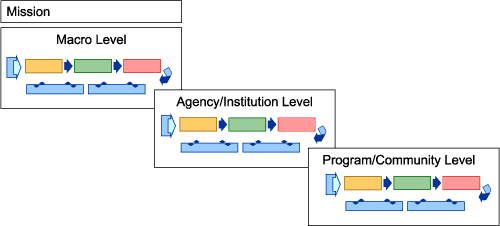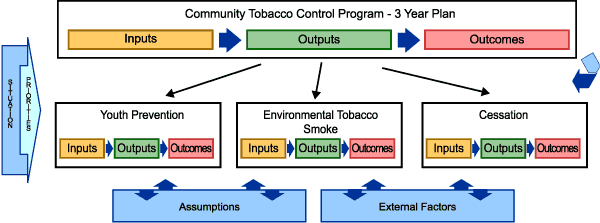Home » Enhancing Program Performance with Logic Models » Section 4: What Does a Logic Model Look Like? » 4.4: Multiple Logic Models
4.4: Multiple Logic Models
Multi-Level Management System
Multiple logic models may be needed to clarify various levels, issues or goals of a single management system. A national initiative, for example, might include the national (most macro) level, the state level, and the community level. Each level is depicted with a logic model in a series of hierarchically linked models. The level of detail may become more specific as the focus narrows.
These “nested” logic models (Wauchope, 2001; Hernandez, 2000) depict the hierarchy of various levels and how they connect within a single system. Each logic model is built with reference to the level above (or below) and in relation to the organization’s or program’s overall mission. This concept is being applied to national community nutrition education work with disparate programs at multiple sites across the United States. This establishment of consistency of purpose and method is essential to the successful implementation of an accountability system.

Multi-component Initiative
In a complex, multifaceted initiative several models might depict the various programmatic components, goals, sites, or target populations. Each of these “sub models” and its expected outcomes links to the overall logic model to ensure that programmatic outcomes are achieved. For example, for a community-wide nutrition education program, there may be one “program” logic model that provides the “big picture” of the total program and then separate, “sub” logic models for the specific programs, components, or target populations within the community-wide effort.
For instance, a community tobacco control effort might have goals related to youth prevention, clean indoor air, and cessation. A general logic model depicts the total effort. Separate, more detailed logic models depict the inputs-outputs-outcomes relative to each component/goal–for example an initiative to change a restaurant ordinance within the environmental tobacco smoke component. Expected outcomes for each of the sub-logic models link to the outcomes expressed in the overall model.





